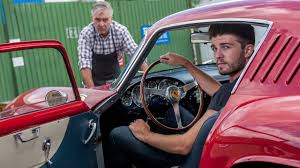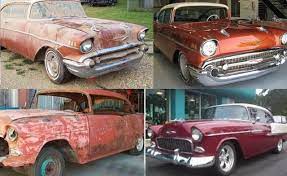Car Restoration
Classic Car Restoration and Preservation: A Guide to Keeping Vintage Cars Alive. Classic cars have a unique place in automotive history, representing a bygone era of craftsmanship, design, and performance. Whether it’s a sleek sports car, a rugged off-roader, or a vintage luxury sedan, classic cars hold a special place in the hearts of enthusiasts and collectors alike. However, preserving and restoring these vehicles can be a daunting task, requiring careful attention to detail, technical know-how, and a passion for the craft. In this article, we’ll explore the world of classic car restoration and preservation, covering everything from the basics of vehicle maintenance to the intricacies of restoring a vintage masterpiece.
The Basics of Classic Car Maintenance
Before embarking on a full-scale restoration project, it’s essential to understand the basics of classic car maintenance. Even the most well-preserved vintage vehicles will require regular upkeep to stay in good working condition. Some key areas to focus on include:
Oil changes and lubrication: Classic cars require regular oil changes and lubrication to keep their engines running smoothly. Be sure to use high-quality oils and lubricants specifically designed for classic cars, as modern formulas may not provide the same level of protection.
Brake and suspension systems
The brakes and suspension systems on classic cars can be more complex than those found on modern vehicles, requiring specialized knowledge and equipment. Regular inspections and maintenance are essential to ensure safe operation.
Electrical systems
Many classic cars feature complex electrical systems, including wiring, switches, and relays. These systems can be prone to corrosion, short circuits, and other issues that can affect performance. Regular inspections and repairs are essential to keep these systems functioning properly.
Tires and wheels Classic cars often feature unique tire and wheel combinations that may be difficult to find or replace. Regular inspections and maintenance are essential to ensure safe operation and prevent damage to these components.
Bodywork and paint Classic cars require regular attention to their bodywork and paint, as exposure to the elements can cause rust, fading, and other damage. Regular cleaning, polishing, and waxing can help protect these components and keep your car looking its best.

Restoration and Preservation Techniques
While regular maintenance is essential to keep your classic car running smoothly, restoration and preservation techniques are necessary to restore a vehicle to its original condition. Some key techniques to consider include:
Rust removal and prevention: Rust is one of the most common issues that classic car owners face, and it can quickly spread and cause serious damage if not addressed promptly. Rust removal techniques include sandblasting, chemical treatments, and welding, while prevention techniques include regular cleaning, waxing, and undercoating.
Engine rebuilding and tuning: Restoring a classic car’s engine requires careful attention to detail and technical know-how. Techniques include disassembly, cleaning, machining, and reassembly, with an emphasis on maintaining the original specs and tolerances. Tuning involves optimizing the engine’s performance through adjustments to fuel and air delivery, ignition timing, and other parameters.
Upholstery and interior restoration: The upholstery and interior of a classic car are often as important as the mechanical components, as they provide the driver and passengers with a unique driving experience. Restoration techniques include replacing or repairing upholstery, carpeting, headliners, and trim, while preservation techniques include regular cleaning and conditioning.
Bodywork and paint restoration: Restoring a classic car’s bodywork and paint requires a high level of skill and attention to detail. Techniques include sanding, filling, priming, painting, and polishing, with an emphasis on maintaining the vehicle’s original contours and finishes.
Finding Parts and Resources
One of the biggest challenges of classic car restoration and preservation is finding the parts and resources needed to complete the job.
some parts may be readily available from aftermarket suppliers or salvage yards, others may be rare or obsolete, requiring specialized knowledge and research to locate. Some key resources to consider include:
Classic car clubs and forums
Classic car clubs and online forums can be a valuable source of information and support for owners and enthusiasts. Members can provide advice, share resources, and offer recommendations on parts suppliers and restoration techniques.
Specialty parts suppliers
Many companies specialize in supplying parts and accessories for classic cars, ranging from engine components to body panels and trim. These suppliers often have access to rare or hard-to-find parts and can provide advice on restoration techniques and best practices.
Restoration shops
Professional restoration shops can provide a full range of services, from basic maintenance and repairs to full-scale restorations. These shops often have access to specialized tools and equipment and can provide expert advice on restoration techniques and best practices.
Preserving the Value of Your Classic Car
Preserving the value of your classic car is essential for maintaining its investment potential and ensuring that it remains a treasured part of automotive history. Some key steps to consider include:
Regular maintenance and cleaning: Regular maintenance and cleaning are essential to preserving the value of your classic car, as they help prevent rust, corrosion, and other forms of damage. Be sure to use high-quality products and techniques specifically designed for classic cars.
Documentation and history: Keeping detailed documentation and records of your classic car’s history can help establish its provenance and authenticity, which can be essential for maintaining its value. Be sure to keep track of any repairs, modifications, or upgrades that have been made, as well as any original paperwork or documentation that came with the vehicle.

Proper storage
Proper storage is essential for preserving the value of your classic car, as exposure to the elements can cause serious damage. Be sure to store your vehicle in a dry, climate-controlled environment, away from direct sunlight and other sources of heat and humidity.
Authenticity and originality: Maintaining the authenticity and originality of your classic car can be essential for preserving its value, particularly if it is a rare or historically significant model. Be sure to use original or period-correct parts and components whenever possible and avoid making modifications that alter the vehicle’s original specs or appearance.
Conclusion
classic car restoration and preservation can be a challenging but rewarding pursuit, providing enthusiasts with the opportunity to bring vintage vehicles back to life and preserve a part of automotive history. Whether you’re a seasoned restorer or a first-time owner, there are plenty of resources and techniques available to help you achieve your goals and keep your classic car running for years to come. By focusing on regular maintenance, restoration and preservation techniques, and careful attention to detail, you can ensure that your classic car remains a treasured part of your collection and a testament to the golden age of automotive design and engineering.
















